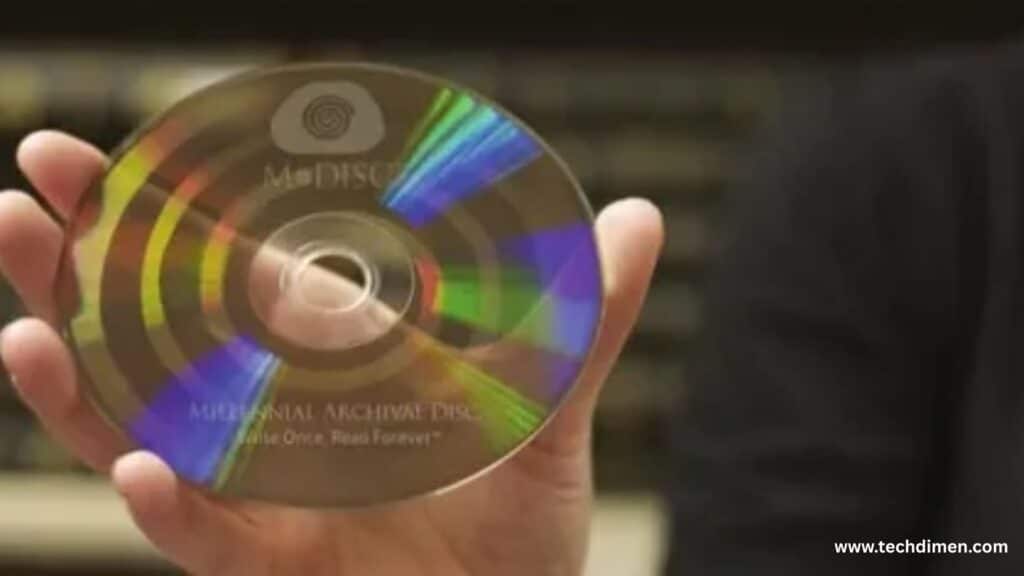Optera Data Archival Disc Technology offers a revolutionary solution for long term data storage. Combining ultra high capacity with exceptional durability, these discs preserve critical information securely for decades. Designed for enterprises and institutions that demand reliable, cost-effective archiving, Optera ensures your data stays safe and accessible well into the future.in the rapidly evolving digital landscape, the demand for reliable, cost-effective, and sustainable data storage solutions has never been greater. Enter Optera Data Archival Disc Technology, a groundbreaking innovation poised to redefine how we preserve data for the long haul.
Optera Data Archival Disc Technology Revolutionary Approach

At the core of Optera Data Archival Disc Technology lies a sophisticated method known as spectral hole burning. This technique involves the use of vanadium doped silicon carbide nanoparticles, which, when exposed to precise laser frequencies, undergo changes in their light emission properties. These alterations, or “spectral holes,” serve as the medium for data encoding, allowing for multi-level data storage within a single layer of the disc .
Unlike traditional optical storage methods that rely on physical pits and lands, Optera’s approach enables higher data densities and improved durability. The use of nanoparticles ensures that the data remains stable over extended periods, making it an ideal solution for archival purposes.
Key Advantages of Optera Data Archival Disc Technology

Exceptional Longevity
Designed to preserve data for over a century, these discs are resistant to environmental factors such as temperature fluctuations, humidity, and magnetic fields.
High Data Density Optera Data Archival Disc Technology
Optera discs boast exceptionally high data density, meaning they can store massive amounts of information in a relatively small physical space. This efficiency comes from advanced optical technologies and precise layering of data on the disc surface. High data density allows organizations to archive huge datasets without needing bulky storage arrays. Compared to traditional optical media, Optera discs pack more bits per square inch, which translates to longer-lasting, compact, and cost-effective storage. This makes them ideal for enterprises handling petabytes of data, offering a smart balance between capacity and durability.
Cost-Effectiveness
Projected manufacturing costs are as low as $0.10 per terabyte, making it a highly economical choice for large-scale data archiving .
Energy Efficiency
Unlike hard drives that require constant power, Optera discs consume energy only during read/write operations, contributing to lower operational costs and a reduced carbon footprint .
Compatibility
Optera Data Archival Discs require specialized optical disc drives designed for high-precision write-once, read-many use. These discs are not readable by standard Blu-ray or DVD drives, but Optera-compatible drives connect easily via common interfaces like USB 3.0, SATA, or SAS, allowing integration with desktops, servers, NAS devices, and automated disc libraries.
On the software side, Optera discs can be formatted using major file systems such as NTFS, exFAT, HFS+, or ext4, making them versatile across Windows, macOS, and Linux platforms. They also work smoothly with archival management software that supports metadata tagging, file verification, and long-term data integrity. For security, Optera supports AES-256 encryption and digital signatures, which is essential for sensitive data like legal or financial records.
Operating system compatibility is broad: Windows fully supports Optera with the necessary drivers, macOS works well with compatible file systems, and Linux offers excellent support. UNIX and BSD systems may require additional tools.
Optera fits naturally into enterprise, government, media, and research workflows by providing a durable, secure, and scalable storage option. Migrating from traditional storage formats like tape or cloud is straightforward, using common backup tools or professional services.
Real World Applications Across Diverse Sectors

The unique attributes of Optera’s archival discs make them suitable for various sectors:
Government and Legal Archives
Ensuring the integrity and longevity of critical documents and records.
Healthcare
Storing sensitive patient data and medical imaging securely over extended periods.
Media and Entertainment
Preserving high-resolution video, audio, and digital assets for future access.
Scientific Research
Archiving vast datasets generated from experiments and simulations.
Enterprise Data Centers
These discs integrate smoothly into existing data center infrastructure, supporting automated robotic libraries and standard server interfaces. Their offline nature adds an extra layer of security against cyber threats, while their compact size helps data centers save space. For enterprises focused on data preservation and disaster recovery, Optera technology delivers a future-proof option that balances capacity with durability and ease of management.
Comparative Analysis: Optera vs. Traditional Storage Solutions
When evaluating storage options, it’s essential to consider factors like cost, longevity, and energy consumption. Here’s how Optera stacks up against traditional mediums:
| Storage Medium | Cost per TB | Lifespan | Energy Consumption | Notes |
|---|---|---|---|---|
| Optera Archival Disc | ~$0.10 | 100+ years | Low | High capacity, durable, energy-efficient |
| Hard Disk Drive (HDD) | ~$11.50 | 3-5 years | High | Shorter lifespan, higher energy usage |
| Magnetic Tape (LTO) | ~$5.00 | 30 years | Moderate | Requires specific handling and storage |
| Cloud Storage | Variable | Depends on provider | High | Ongoing costs, dependent on internet access |
Future Prospects and Development Roadmap
Optera is actively working towards scaling its technology for broader adoption. Short-term goals include producing 1TB discs, with ambitions to achieve 10TB discs at a manufacturing cost of $1 by the end of the decade . Long-term objectives focus on further reducing costs and enhancing data density through volumetric recording techniques .
The company is also exploring partnerships with established optical disc manufacturers and library system providers to facilitate the integration of its technology into existing infrastructures .
Acquiring Optera Discs and Equipment
As Optera progresses towards commercialization, interested parties can stay informed and express interest through their . The company is open to collaborations and is seeking partners to help bring this innovative storage solution to market.
FAQs

What exactly is Optera Data Archival Disc Technology?
Optera Data Archival Disc Technology is a cutting-edge optical storage solution designed specifically for long-term data preservation. Unlike regular DVDs or Blu-rays, Optera discs use advanced materials and precise engineering to achieve exceptionally high data density and durability. This technology ensures your critical information can be safely stored for many decades without degradation, making it ideal for enterprises, government agencies, media companies, and anyone needing reliable, offline archival storage.
How long can data safely remain stored on Optera Data Archival Disc Technology?
Optera discs are engineered to keep data intact for anywhere between 50 to 100 years under the right storage conditions. Their composition protects against common issues like disc rot, environmental wear, and data corruption that plague traditional storage media such as magnetic tapes or hard drives. This means your files, records, or media can be accessed reliably decades from now, making Optera a future-proof choice for long-term archiving.
Can I read or write data on Optera discs using my regular Blu-ray or DVD drives?
No, Optera discs require specialized archival-grade optical drives that are specifically built to handle their higher data density and unique materials. Standard Blu-ray or DVD players lack the precision and laser technology needed to read or write Optera discs. To use Optera media, you’ll need compatible drives which are often available through enterprise hardware vendors or directly from Optera-certified partners.
Which file systems are compatible with Optera Data Archival Discs?
One of the great things about Optera discs is their flexibility. They support a variety of widely-used file systems including NTFS, which is common in Windows environments; exFAT, known for cross-platform compatibility; HFS+ and APFS for macOS users; and ext4, which is popular in Linux distributions. This versatility makes Optera discs highly adaptable and easy to integrate into mixed IT environments without worrying about compatibility headaches.
How secure are Optera discs for storing sensitive or confidential data?
Optera discs offer robust security features to protect sensitive data. They are compatible with strong encryption standards such as AES-256, which ensures that data stored on the disc cannot be accessed without the proper decryption key. Additionally, Optera technology supports digital signatures and integrity checks to verify that the data has not been tampered with. These security capabilities make Optera suitable for archiving highly confidential records, including legal documents, financial information, and healthcare data.
How does Optera archival technology compare to traditional magnetic tape storage?
While magnetic tape has long been a staple of archival storage, Optera discs provide several distinct advantages. They have superior durability and resist damage from environmental factors such as humidity, temperature fluctuations, and magnetic fields, which often degrade tapes over time. Optera discs also allow for quicker random access to data, as they don’t require sequential reading like tapes do. This means faster retrieval times and less maintenance, making Optera a more efficient and reliable archival medium for modern enterprise needs.
Can Optera discs be integrated into existing enterprise data center workflows and infrastructure?
Yes, Optera discs are designed with enterprise integration in mind. They are compatible with automated disc libraries and robotic systems commonly used in data centers. Their connection options include standard interfaces like USB 3.0, SATA, and SAS, allowing easy installation alongside existing servers and storage systems. Additionally, their offline nature enhances security by reducing vulnerability to cyberattacks. This makes Optera an excellent choice for companies seeking scalable, secure, and cost-effective long-term storage solutions.
What types of data or applications are best suited for storage on Optera archival discs?
Optera discs excel at storing large, valuable datasets that require long-term preservation. This includes compliance and regulatory records, scientific research data, video and media archives, backup files, and any information that must remain intact and accessible for decades. Because of their stability and longevity, Optera discs are perfect for organizations that cannot afford data loss, such as legal firms, broadcasters, universities, and government agencies.
Is transferring or migrating existing data to Optera discs a complicated process?
Migrating data to Optera discs is typically straightforward and can be done using standard backup and migration software tools. Many organizations use scripts or third-party applications to automate the process, making it efficient even when dealing with large volumes of data. For more complex setups, certified Optera partners often provide professional migration services to ensure data integrity and smooth transition. This ease of migration reduces downtime and lowers the barriers to adopting Optera technology.
Where can I purchase Optera Data Archival Discs and compatible drives?
Optera discs and drives are available through authorized distributors and vendors that specialize in archival and enterprise storage solutions. You can find them through certified resellers or by contacting Optera’s official sales channels. Working with certified partners ensures you get genuine products along with professional support and guidance on setup, integration, and maintenance tailored to your specific storage needs.
Conclusion
Optera Data Archival Disc Technology represents a significant advancement in the realm of long term data storage. By combining high capacity, exceptional durability, and cost-effectiveness, it addresses the pressing needs of various industries for reliable archival solutions. As data continues to grow in volume and importance, technologies like Optera’s will play a crucial role in ensuring that information remains accessible and secure for generations to come.

Jhon AJS is a tech enthusiast and author at Tech Dimen, where he explores the latest trends in technology and TV dimensions. With a passion for simplifying complex topics, Jhon aims to make tech accessible and engaging for readers of all levels.







